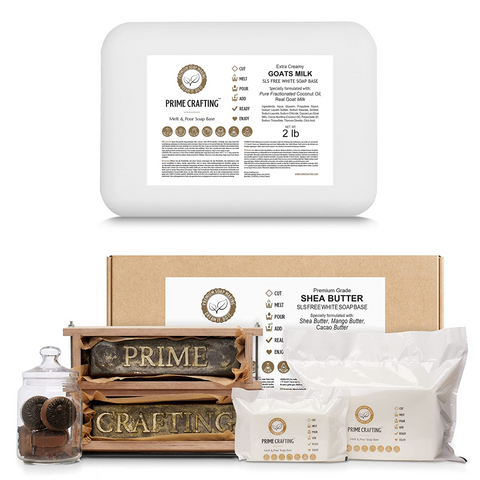Soap base: features and benefits of use

Soap base, also known as melt and pour soap base, is a premade soap mixture that is melted down and used as the base for creating handmade soaps. It typically consists of a blend of natural oils, glycerin, and other ingredients that are melted together and poured into a mold to create a bar of soap. The soap base is already saponified, meaning that the oils and fats have already reacted with an alkaline solution to create soap, so it is not necessary to handle lye, which is a caustic and dangerous substance, in the soap-making process.
Types of soap bases

There are several types of soap bases that can be used to make soap. Some common types include:
- Glycerin soap base: This type of soap base is made with glycerin, a natural humectant that helps to draw moisture to the skin. Glycerin soap is usually clear or translucent, and can be easily melted down and poured into molds. You can buy Glycerin soap base here.
- Shea butter soap base: Shea butter is a rich, natural emollient that is often used in skin care products. Shea butter soap base is creamy and luxurious, and is often used in soaps designed for dry or sensitive skin. You can buy Shea butter soap base here.
- Olive oil soap base: Olive oil is a nourishing and moisturizing oil that is often used in soap making. Olive oil soap base is typically green or yellow in color, and has a rich, creamy lather.
- Coconut oil soap base: Coconut oil is a popular ingredient in soap making, thanks to its ability to create a rich, bubbly lather. Coconut oil soap base is often used in soaps designed for oily or acne-prone skin.
- Castile soap base: Castile soap is made with olive oil and is known for its gentle, moisturizing properties. Castile soap base can be used to make a variety of different types of soap, including liquid soap.
- Goat milk soap base: Goat milk soap base is made with fresh goat milk, which is rich in vitamins and minerals that are beneficial for the skin. Goat milk soap is often used in soaps designed for sensitive or dry skin. You can buy Goat milk soap base here.
- Aloe vera soap base: Aloe vera is a natural moisturizer that is often used in skin care products. Aloe vera soap base is typically clear or translucent, and is often used in soaps designed for sunburned or irritated skin.
White and clear soap bases are two common types of soap bases used in soap making.

White soap base, also known as opaque soap base, is typically made with a combination of oils and fats, such as coconut oil, palm oil, and olive oil, and it contains titanium dioxide to give it a white color. It produces a creamy, opaque lather and is ideal for adding colors, fragrances, and exfoliants.
Clear soap base, also known as transparent soap base, is typically made with a combination of oils and fats, such as coconut oil, palm oil, and castor oil, and it contains glycerin and sometimes alcohol to give it a transparent appearance. It produces a clear, bubbly lather and is ideal for adding colors, fragrances, and embeds.
Both white and clear soap bases are versatile and easy to use, and they are often used as the foundation for creating custom soaps by adding additional ingredients and scents.
How to use soap base

Soap base is a pre-made soap mixture that can be melted down and customized with your own additives, fragrances, and colors to create your own handmade soap. Here are the steps to using soap base:
- Choose your soap base: There are different types of soap bases available such as glycerin, shea butter, goat milk, and more. Choose the one that best suits your needs.
- Cut the soap base into small pieces: Use a knife or a soap cutter to cut the soap base into small pieces. This will make it easier to melt down.
- Melt the soap base: You can melt the soap base in a microwave or a double boiler. If using a microwave, place the soap base in a microwave-safe bowl and heat it in 30-second intervals, stirring in between, until fully melted. If using a double boiler, place the soap base in the top pan and heat over simmering water, stirring occasionally, until fully melted.
- Add your desired additives: Once the soap base is melted, you can add your desired additives such as fragrance oils, essential oils, colorants, exfoliants, and more. Stir well to ensure they are fully incorporated.
- Pour the soap mixture into molds: Pour the soap mixture into soap molds and allow it to cool and harden. Depending on the soap base used, this can take anywhere from a few hours to overnight.
- Remove the soap from the molds: Once the soap has hardened, remove it from the molds and store it in an airtight container until ready to use.
Note: Always follow the instructions on your soap base packaging for the best results.
Where to buy soap base

In our online store Essencetics you can buy a wide range of soap bases and other products for the manufacture of natural cosmetics. Go to the catalog and choose the product you need.
We guarantee the high quality of our products, fast shipping, pleasant discounts for regular customers.


